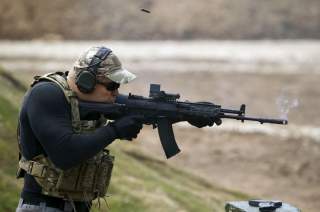Russia's AK-12 Rifle: The Best In the World or a Waste of Time?
Or something in between? Take a look.
On April 6, 2019, the Russian Ministry of Defense signed a three-year contract with Kalashnikov Concern for 150,000 AK-12 rifles. This is Russia’s first large purchase of an updated rifle since the AK-74M in the 1990s. But how does the AK-12 improve upon the AK-74M, the last service rifle of Russia?
The heart of the AK-12 is the free-floated barrel. On all previous AK rifles, the lower handguard of the rifle was mounted directly on the barrel with a stamped steel handguard retainer. As a result, any force on the handguard will affect the zero of the rifle. This could be a soldier pulling down or resting the handguard on a sandbag, using the sling of the rifle to stabilize it. The direct attachment also can cause the handguard to heat up faster, as the handguard is in direct contact with the barrel in some places.
Free-floating eliminates the contact between the handguard and the barrel, improving accuracy. The AK-12 free-floats its handguard by making the lower handguard lock into the upper handguard with matching slots and bolts. The upper handguard remains on the gas tube, which remains relatively isolated from the barrel by the light contact between the barrel and gas tube.
This approach to free-floating is not novel. H&K used a similar solution to free-float barrels on G3A3 rifles and later MP5s. But the AK-12 marks the first time a production AK rifle has a free-floated barrel.
The AK-12 also incorporates a variety of ergonomic and functional improvements. Little spikes have been added to the front of the flash hider so soldiers can easily break glass in a building to create a firing position. The stock is adjustable for length and folding, to allow for better adaptation to soldiers of different heights.
The optics mounting systems of the AK-12 are also significantly different from the AK-74. The AK-12 features a reinforced, locking dust cover with a Picatinny rail. Sights can be mounted directly on this cover. Because of the new rail, the AK-12 doesn’t have a dovetail rail on the side of the rifle. Rails are also present on the handguard for the mounting of other accessories.
This could pose a problem, as older night vision sights like the NSPU are mounted on the dovetail rail. But AK-12s are likely to be issued to units with priority for advanced gear to begin with, so it is unlikely to be much of a problem.
The iron sights of the AK-12 are also improved versus the AK-74M, although the change could be a controversial move. The AK-12’s iron sights are peep sights mounted close to the shooter’s face, similar to those on the M16. This allows for more accurate fire, with the tradeoff of the sights requiring more training to use rapidly and effectively.
Comparatively, the earlier AKs’ open iron sights are rapid to pick up for new shooters and easier to train on. The decision to go with a peep sight might reflect the increasing professionalization of the Russian military.
The AK-12 will also be issued with a new magazine that features a bevel where the bottom of the mag touches the ground, for improved stability when “monopodding” on the magazine. The magazine also features windows on the side so a soldier can see how many rounds are remaining. This is similar to the PMAGs the USMC standardized, and the semi-transparent mags used by some militaries.
Unfortunately for users of the AK-15, these improved magazines are only available for the AK-12 in 5.45 caliber. 7.62x39 magazines shown with the AK-15 have been the same magazines provided with the AK-103, the 7.62x39 version of the AK-74M.
Overall, the AK-12 represents an improvement in almost every aspect versus the AK-74M. The ergonomic changes are an amalgamation of aftermarket upgrades that were already available and used on the AK-74M by some Russian SOF units and other military units.
Charlie Gao studied political and computer science at Grinnell College and is a frequent commentator on defense and national-security issues.
Image: Reuters.

